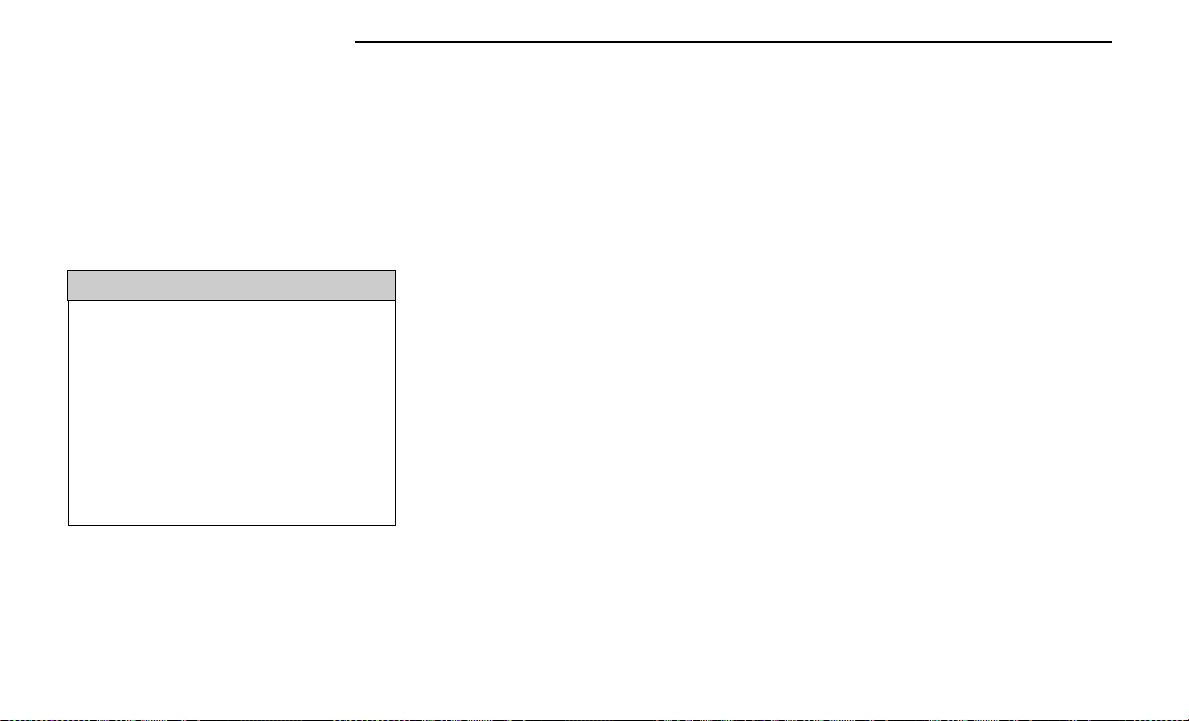Loading ...
Loading ...
Loading ...

12. Reattach the glove compartment tension tether by
inserting the tether clip in the glove compartment
and sliding the clip away from the face of the glove
compartment door.
NOTE:
Ensure the glove compartment door hinges and
glove compartment travel stops are fully engaged.
ACCESSORY DRIVE BELT
INSPECTION
WARNING!
•
Do not attempt to inspect an accessory drive belt
with the vehicle running.
•
When working near the radiator cooling fan, dis-
connect the fan motor lead. The fan is temperature
controlled and can start at any time regardless of
ignition mode. You could be injured by the moving
fan blades.
•
You can be badly injured working on or around a
motor vehicle. Only do service work for which you
have the knowledge and the proper equipment. If
you have any doubt about your ability to perform a
service job, take your vehicle to a competent
mechanic.
When inspecting accessory drive belts, small cracks
that run across ribbed surface of belt from rib to rib, are
considered normal. These are not a reason to replace
the belt. However, cracks running along a rib (not
across) are not normal. Any belt with cracks running
along a rib must be replaced. Also have the belt
replaced if it has excessive wear, frayed cords or severe
glazing.
Conditions that would require replacement:
•
Rib chunking (one or more ribs has separated from
belt body)
•
Rib or belt wear
•
Longitudinal belt cracking (cracks between two ribs)
•
Belt slips
•
Groove jumping (belt does not maintain correct posi-
tion on pulley)
•
Belt broken (identify and correct problem before
new belt is installed)
•
Noise (objectionable squeal, squeak, or rumble is
heard or felt while drive belt is in operation)
Some conditions can be caused by a faulty component
such as a belt pulley. Belt pulleys should be carefully
inspected for damage and proper alignment.
Belt replacement on some models requires the use of
special tools, we recommend having your vehicle ser-
viced at an authorized dealer.
BODY LUBRICATION
Locks and all body pivot points, including such items as
seat tracks, door hinge pivot points and rollers, liftgate,
tailgate, decklid, sliding doors and hood hinges, should
be lubricated periodically with a lithium-based grease,
such as Mopar® Spray White Lube to ensure quiet,
easy operation and to protect against rust and wear.
Prior to the application of any lubricant, the parts con-
cerned should be wiped clean to remove dust and grit;
after lubricating excess oil and grease should be
removed. Particular attention should also be given to
hood latching components to ensure proper function.
When performing other underhood services, the hood
latch, release mechanism and safety catch should be
cleaned and lubricated.
The external lock cylinders should be lubricated twice a
year, preferably in the Autumn and Spring. Apply a small
amount of a high quality lubricant, such as Mopar®
Lock Cylinder Lubricant directly into the lock cylinder.
WINDSHIELD WIPER BLADES
Clean the rubber edges of the wiper blades and the
windshield periodically with a sponge or soft cloth and
a mild nonabrasive cleaner. This will remove accumula-
tions of salt or road film.
Operation of the wipers on dry glass for long periods
may cause deterioration of the wiper blades. Always
use washer fluid when using the wipers to remove salt
or dirt from a dry windshield.
Avoid using the wiper blades to remove frost or ice from
the windshield. Keep the blade rubber out of contact
with petroleum products such as engine oil, gasoline,
etc.
Accessory Belt (Serpentine Belt)
302 SERVICING AND MAINTENANCE
Loading ...
Loading ...
Loading ...